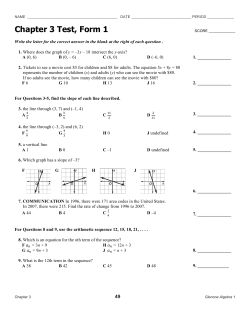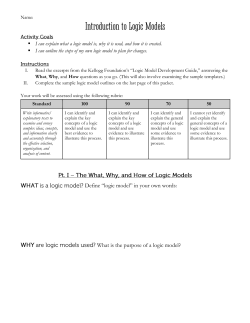
Assignment 1 2015
SCHOOL OF ELECTRICAL ENGINEERING & TELECOMMUNICATIONS ELEC2141 – DIGITAL CIRCUIT DESIGN ASSIGNMENT I DUE DATE: 17th April 2015 Your assignment solutions are to be submitted at the assignment box at the school office. Attach completed and signed assignment submission form as a front page to your submission. For each of the design question, you may use Xilinx ISE or PSPICE or any other appropriate CAD tool to simulate and verify your design. Question 1 An Arithmetic Logic Unit (ALU) is at the heart of all computers as well as most digital hardware systems. It is a combinational network that performs logical and arithmetic operations. An n-bit ALU typically has two input words A and B, each of which denoted by A=An-1An-2…Ao and B = Bn-1Bn-2…Bo. The output word is denoted by F = Fn Fn-1…Fo, where the high order output Fn is actually a carry-out. In addition, there is a carry-in input Co. Besides data inputs and outputs, an ALU must have control inputs for specifying the operations to be performed. The control inputs include a mode selector, M, and operation selector inputs, So and S1. The mode selector is needed to decide whether logical or arithmetic operation is to be performed and the operation select inputs are required to determine which particular logic or arithmetic function is to be performed. The specification of a simple ALU bit slice, that is the behaviour of a single bit of an ALU, is given in Table 1. The operations are broken down into three sections: logical operations, arithmetic operations where the carry-in is 0, and arithmetic operations where the carry-in is 1. Based on the specification, design an 8-bit ALU. Your design should begin with a 1bit slice of the ALU and then cascade them to build the desired 8-bit ALU. Note the single bit slice will have six inputs: Ai, Bi, Ci, M, S1, and So, and two outputs: Fi and Ci+1 (carry-out). Your design should include your choice of circuit implementation, simulation and verification. For the purpose of this assignment, it will be suffice to show the simulation and verification of the 1-bit slice of the ALU. Your design should aim at achieving optimized implementation and include calculation of gate input cost. M=0, Co=X S1 So 0 0 0 1 1 0 1 1 M=1, Co=0 S1 So 0 0 0 1 1 0 1 1 M=1, Co=1 S1 So 0 0 0 1 1 0 1 1 Function Logical Bitwise Operation comment Fi = Ai Fi = NOT Ai Fi = Ai XOR Bi Fi = Ai XNOR Bi Arithmetic Operations F=A F = NOT A F=A+ B F = (NOT A) + B Arithmetic Operations F=A+1 Increment F = (NOT A) + 1 F=A+ B+1 F = (NOT A) + B + 1 B-A Table 1: Specification for ALU Question 2 Design a digital circuit that controls a security system. The security system consists of an alarm (E), a floodlight (F), a daylight detector (D), a motion detector for potential criminals (C) and a switch that sets the security mode. The switch has four settings marked as mode 0, 1, 2 and 3. When the switch is set to mode 0, the floodlight will be turned OFF but the alarm should be ON if a potential criminal is detected at night time. When the switch is set to mode 1, the floodlight should be turned ON and the alarm should be OFF. The switch needs to be set to mode 2 if the floodlight is to be turned ON when a potential criminal is detected at night time. When turning the floodlight ON at night time is required, the switch is to be set to mode 3. In any mode, the floodlight and alarm should not be ON at the same time. The switch outputs 2-bit binary code (A, B) corresponding its mode. For example, when the switch is set to mode 2, it outputs AB = ‘10’. Assume the floodlight and detector signals are active high. This means floodlight is turned ON when driven by logic “1” and the detector output is “1” when detection is asserted. The desired digital circuit will generate a binary output which will control the floodlight and the alarm through their respective driving circuits and will take the daylight detector, the motion detector, and the binary outputs from the switch that sets the security mode as inputs. Your design should include your design procedure, choice of implementation, simulation and verification. The gate input cost must be calculated.
© Copyright 2025











